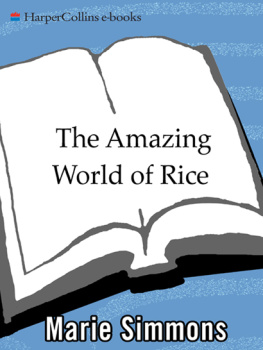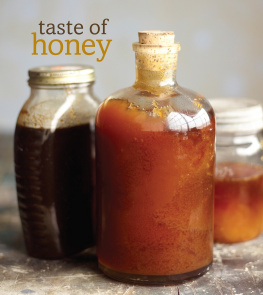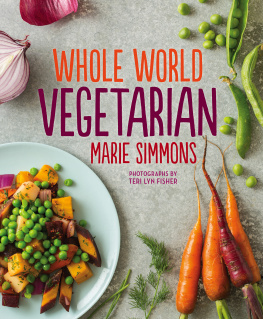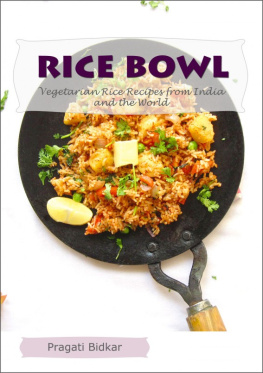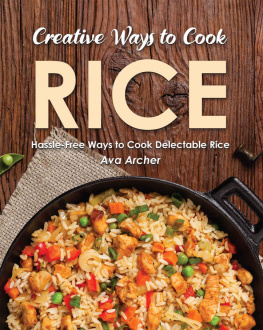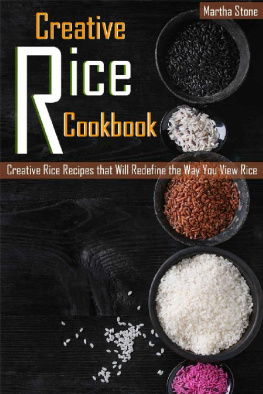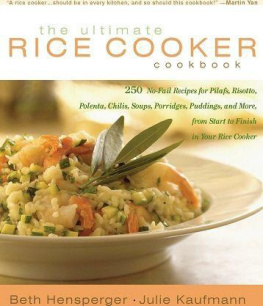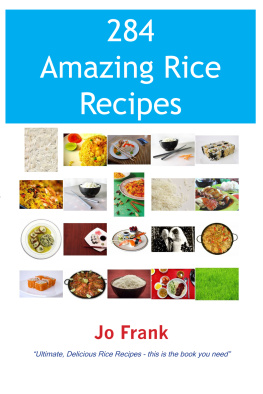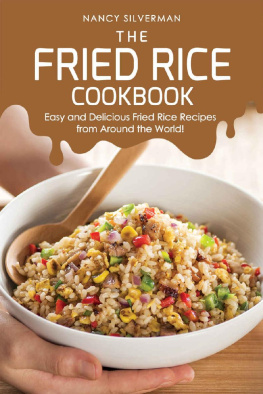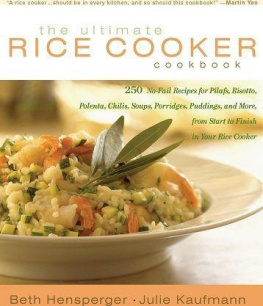The Amazing World of Rice
with 150 Recipes for Pilafs, Paellas, Puddings, and More
Marie Simmons

FOR THE COOKS IN MY FAMILY
Nana (in memory), my mentor
Mom, my inspiration
Aunt Tess, my idol
Aunt Rita, my role model
Stephanie, my guiding light
Seraphina, the brightest light in my life
Contents
M ore than ten years ago I spent several years exploring the world of rice while working on Rice, the Amazing Grain. I became fascinated with rice because I didnt know very much about it. At the time risotto was new to me and pilaf exotic. I realized that even stir-fries, salads, and puddings were dishes I yearned to explore in depth. I turned that curiosity into a book, researching and gathering a treasury of information and experimenting endlessly with rice recipes. Along the way I not only learned to cook rice but also learned to love it.
My fascination with rice did not end in 1991 when Rice, the Amazing Grain was published. Nor did it end, a decade later, when the book went out of print.
Over the years my rice education continued to grow. In my travels to Asia, the Mediterranean region, and South America I have eaten rice, learned to cook more rice dishes, and tried new (to me) varieties of rice. Meanwhile at home demographics have radically changed the profile of the restaurants where we eat and the markets where we shop. I dont have to go to Bangkok to eat coconut rice pudding with mango or to Delhi to find baby basmati rice. To add to the excitement, the United States is producing more varieties of rice, and many exotic rices are being imported from Asia and other parts of the world.
With so many new recipes and new rice information milling about in my head, writing a second book was inevitable. But I did it only because Harriet Bell, an editor and friend, said decisively, Lets do it, over a glass of iced tea when I casually mentioned that maybe some day I should write another book about rice.
A cookbook is never a solitary task. Recipes, stories, and information come from many sourcescolleagues, new friends, old friends, and family.
Revisiting my decade-plus old notes and dog-eared fat files (there are some advantages to being a pack rat) reminded me of the kindness and generosity of the people who were there to advise and encourage me through the process of writing and researching Rice, the Amazing Grain, my first real cookbook. They are Susan Herner, Elizabeth Crossman, Kris OBrien, and Gloria Spitz.
Thank you to the experts and growers in the industry who have continued to help me over the years with my various rice projects: Richard Long and Mark Denman at RiceTec, Inc., in Alvin, Texas, Donna Bayliss of Bayliss Ranch in Biggs, California, Michael Martin at the Martin Rice Company in Bernie, Missouri, the Lundberg Family Farms in Richvale, California, and Timothy Johnson of the California Rice Commission.
Now, many yearsand cookbooks laterI am fortunate to have more people to whom I express my gratitude: Judith Weber, my stalwart agent and loyal confident, Ken Lee and Caryl Levine of Lotus Foods, who keep me supplied with their incredibly beautiful exotic grains, and Dr. Henry Beachell, rice expert at RiceTec who patiently vetted my new rice glossary. Special thanks to Kim Park, the National Consumer Education Director at USA Rice Federation, and Kasma Loha unchit, friend, cookbook author, and excellent Thai cooking teacher who taught me to cook rice, Thai-style.
Thank you to Brooke Jackson for expertly retesting many of my recipes, to Libby Connolly at The Spanish Table in Berkeley, California, for her paella advice, to Judith Sutton for correcting my mistakes and asking all the right questions, and to book designer Lee Fukui for such a beautiful book.
Finally, but not least, I thank our good friends and our neighbors for putting up with all the rice leftovers that I plied them with (or left on their doorsteps if they happened not to be at home). And an especially loving thank you to John for being there at the table, uncomplaining, as I fed him meal after meal of rice, rice, and more rice.
How nice
Is rice!
How gentle and how very free from vice
Are those whose fodder is mainly Rice.
Yes: Rice! Rice!
Beautiful Rice!
All the wrong in the world would be right in a trice
If everyone fed upon nothing but Rice.
O f all the foods in the world, rice as this little poem expresses, is the gentlest of foods. The grains, gracefully curved on two sides, come together in a soft point at each end. The absence of any true color is in itself a small comfort. When cooked, its softness soothes both hunger and soul.
Rice, a staple for billions of people on earth, is more than food. Rice is rich in legend and folklore that reaches far beyond the bags and boxes found in the kitchens of the world. In Southeast Asia especially, people believe rice is the link between heaven and earth. Intertwined in the customs, language, and arts of Asian culture, rice is the symbol of fertility, beauty, sensitivity, prosperity, energy, and life.
Throughout Asia rice is an integral part of the Creation myth and a gift from the gods, as these two tales illustrate:
In the Philippines, a legend about a beautiful young girl named Bright Jewel and the handsome god who loved her has been told and retold for centuries. Bright Jewel insisted that the young god go into the great beyond in search of a food more delicious than she had ever tasted and bring it back to her as a token of his love. When a very long time had passed and he hadnt returned, Bright Jewel, filled with grief, died of a broken heart. The first rice plant grew from her grave.
In Indonesia, the following legend is a favorite: The god Anta was very poor, and he had no gift for the temple of the great god Batara Guru. He wept three tears. Each tear turned into an egg. Anta had to fight to protect the eggs from a fierce eagle, and before it could destroy the third one, the egg cracked and hatched a lovely female baby named Samyam Sri. The gods wife nursed the baby, who grew into a lovely maiden. Batara lusted for Samyam Sri; tragically, the other goddesses killed her to save her from being ravaged by Batara. As the goddesses mourned Samyam Sri, plants and grasses grew from her grave. Rice was among the plants and for this reason rice in Indonesia is often called, with great reverence, Samyam Sri.
Where Rice Grows
Rice is so ancient that the exact time and place of its first cultivation may never be known. However, grains of rice found imprinted in pottery shards unearthed in Thailand have been carbon dated to 4000 B.C . There, as throughout Southeast Asia, in China, and in India, rice is the primary agricultural crop and is consumed at every meal.
Rice grows throughout the world, from the low hot plains of Texas to the high cold mountains in Bhutan, from the foot of the Andes Mountains in central Argentina to the flood waters of Bangladesh, and from the humid tropics of India to the semi-arid dry lands of Australia. Antarctica is the only continent on the earth where rice does not grow.
In North America, the colonists first planted rice along the coast of the Carolinas in the late 1600s. By the 1700s, rice was firmly established as a valuable export commodity that had made some plantation owners very wealthy. During this time Carolina Gold Rice was being shipped to England. Then, as now, the United States exported more rice than it consumed. By the late 1800s, the once thriving rice industry was diminished by the ravages of the Civil War. But, with the birth of the Industrial Revolution, the industry moved inland to Arkansas, Louisiana, Mississippi, Missouri, and Texas. Eventually the Gold Rush brought the rice industry to California. Today Arkansas and California are the top two rice producers in the United States, and the United States continues to be a major exporter in the world rice market.

